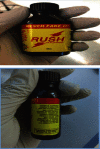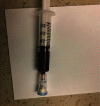Altered Mental Status and Cyanosis in a Pediatric Patient with Methemoglobinemia
- PMID: 33274100
- PMCID: PMC7695503
- DOI: 10.1155/2020/8896754
Altered Mental Status and Cyanosis in a Pediatric Patient with Methemoglobinemia
Abstract
Methemoglobinemia results from increased amounts of oxidized hemoglobin in the blood with an ensuing change in oxygen dissociation curve and lack of oxygen delivery to tissue. A previously well, male toddler was brought to the Pediatric Emergency Department (PED) by Emergency Medical Services (EMS) with abrupt onset of altered mental status and cyanosis after a suspected ingestion of "Rush" nail polish remover. He was quickly diagnosed with methemoglobinemia by both clinical presentation and chocolate-colored blood appearance. He emergently received intravenous (IV) methylene blue (MB) with immediate and sustained improvement requiring no further doses. Though inhalation of nitrites and subsequent methemoglobinemia is frequently reported in adolescents, we were unable to find any cases in the literature detailing ingestion of this product and the resulting clinical manifestations. Our objective with this report is to describe a rare case of a toddler with an accidental ingestion of "Rush" nail polish remover, a nitrite compound. Our patient presented to the PED with abrupt onset of altered level of consciousness, hypotension, and cyanosis resulting from acquired methemoglobinemia. This case report demonstrates the importance of emergency clinicians being able to make clinical judgements and decisions based on the history and physical exam when methemoglobinemia is suspected.
Copyright © 2020 Phillip M. Grenz et al.
Conflict of interest statement
The authors declare no conflicts of interest.
Figures
References
Publication types
LinkOut - more resources
Full Text Sources
Miscellaneous



